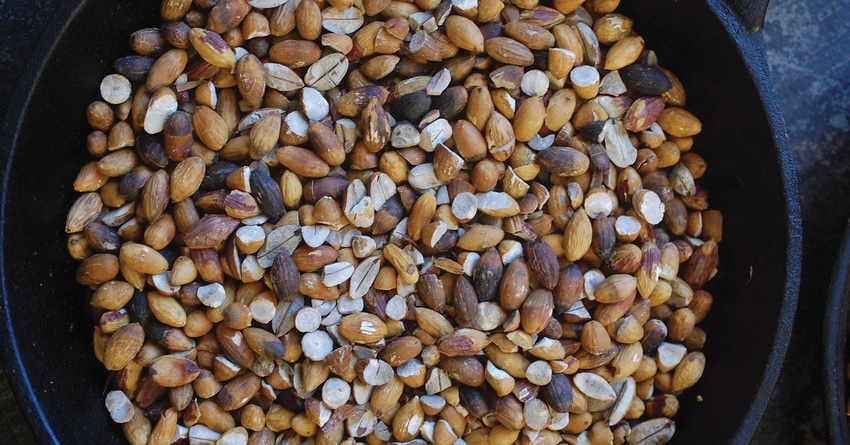
Commercial growers of acorns range from few to none, although the oak tree fruits were once a major source of food for indigenous peoples in Southern California who gathered the more prevalent Coast Live Oak.
The favored acorn, however, came from the California Black Oak, which was a bit harder to find as it grows in California’s mountainous regions. It was there the Kumeyaay and Luiseno tribal members made special trips during the fall harvest to collect acorns to be stored for up to a year in willow granary baskets until such time as they were ground into meal on bedrock mortars.
One anthropologist estimated that subsistence demands could be met during annual acorn production despite the fact that more than three quarters of the entire California Native population relied on acorns for food on a daily basis.
The more accessible Coast Live Oak could be found on the west side of the Sierra Nevada and Coast Range mountains from San Francisco south to northern Baja. Growing up to 70 feet tall with lots of branches and a full crown, the live oak was the dominant plant throughout southern California’s chaparral and pine/oak woodlands.
Live oak acorns were considered a delicacy with the seeds ground into a milled powder after the tannins were leached out to improve the taste. Once reduced to a flour, acorn meal would be mixed with water to make a bread, cake, or an acorn gruel. The acorn powder was sometimes toasted and brewed with water to serve as a form of coffee.
Not only were acorns used for food or drink, they served other purposes as well. Chipped live oak bark was made into a decoction to be used as an antiseptic. Acorn meat was used as a means to repay a shaman for services provided. And small game hunters used oak acorns for trap bait.
“No other food has sustained the human race to such an extent as the acorn,” said biologist/herbalist John Slattery, author of Southwest Foraging. “If you took a gigantic table and laid out all the foods that humans have eaten across the globe and throughout time, making an individual pile for each foodstuff, acorns would be, by far, the largest pile on the table.”
Use has diminished
While acorns still play a part in seasonal festivals, their use as a food source has diminished and they represent a link with traditions of the past.
“Today, few people are even aware that acorns can be eaten,” says Slattery. “How can such an abundant food source go unnoticed for so many generations? I’m hoping for an Age of Acorn Renaissance, a reawakening to the vitality and nutrition present in a variety of culinary delights based on acorns.”
In Northern Arizona’s high mountain country, Apaches still search out what they call “The Kings Food” or Chichle, a key ingredient in traditional harvest recipes passed down for generations. “When the rains come and acorns drop in cooler weather, we know collection time is here,” said one collector with years of experience.
There are over 400 species of oak worldwide, some 30 of them in the U.S., and all nutritious because of carbohydrate and protein content as well as all 8 essential amino acids.
For those who would like to become a “balanophagist” — a person who eats acorns -- a reminder that they must be foraged and while an average adult oak tree can produce about 2,000 acorns over a season, it takes a full two gallons of usable nuts in the shell -- that must be shelled by hand or with an acorn harvester— to yield enough meats to make it worthwhile.
For more news on tree nuts as reported by growers and farm advisors, subscribe to the Tree Nut Farm Press e-newsletter.
Read more about:
AcornsAbout the Author(s)
You May Also Like




